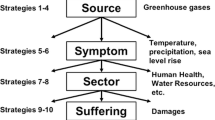Towards the “Perfect” Weather Warning
Overview
- Editors:
-
-
Brian Golding
-
Met Office, Exeter, UK
- Discusses how to make weather warnings more effective through interorganizational communication and partnerships
- Offers a framework that bridges government, private business, civil society and the voluntary sector
- Emphasizes the decision makers as the primary paradigm in the warning and forecasting process
- This book is open access, which means that you have free and unlimited access
About this book
This book is about making weather warnings more effective in saving lives, property, infrastructure and livelihoods, but the underlying theme of the book is partnership. The book represents the warning process as a pathway linking observations to weather forecasts to hazard forecasts to socio-economic impact forecasts to warning messages to the protective decision, via a set of five bridges that cross the divides between the relevant organisations and areas of expertise. Each bridge represents the communication, translation and interpretation of information as it passes from one area of expertise to another and ultimately to the decision maker, who may be a professional or a member of the public. The authors explore the partnerships upon which each bridge is built, assess the expertise and skills that each partner brings and the challenges of communication between them, and discuss the structures and methods of working that build effective partnerships. The book is ordered according to the “first mile” paradigm in which the decision maker comes first, and then the production chain through the warning and forecast to the observations is considered second. This approach emphasizes the importance of co-design and co-production throughout the warning process. The book is targeted at professionals and trainee professionals with a role in the warning chain, i.e. in weather services, emergency management agencies, disaster risk reduction agencies, risk management sections of infrastructure agencies.
This is an open access book.
Similar content being viewed by others
Table of contents (8 chapters)
-
-
-
- Robert Šakić Trogrlić, Marc van den Homberg, Mirianna Budimir, Colin McQuistan, Alison Sneddon, Brian Golding
Pages 11-46Open Access
-
- Anna Scolobig, Sally Potter, Thomas Kox, Rainer Kaltenberger, Philippe Weyrich, Julia Chasco et al.
Pages 47-85Open Access
-
- Cheryl L. Anderson, Jane Rovins, David M. Johnston, Will Lang, Brian Golding, Brian Mills et al.
Pages 87-113Open Access
-
- Joanne Robbins, Isabelle Ruin, Brian Golding, Rutger Dankers, John Nairn, Sarah Millington
Pages 115-147Open Access
-
- Brian Golding, Jenny Sun, Michael Riemer, Nusrat Yussouf, Helen Titley, Joanne Robbins et al.
Pages 149-200Open Access
-
- Paul Joe, Jenny Sun, Nusrat Yussouf, Steve Goodman, Michael Riemer, Krishna Chandra Gouda et al.
Pages 201-254Open Access
-
-
Back Matter
Pages 265-270
Editors and Affiliations
-
Met Office, Exeter, UK
Brian Golding
About the editor
Prof. Brian Golding is a Research Fellow in Weather Impacts at the Met Office, and is Co-Chair of the WMO/WWRP HIWeather project, which aims to enable increased global resilience to severe weather by improving forecasts of severe weather and its impacts, and the communication of information to users, especially emergency managers. Brian has been involved in Numerical Weather Prediction since joining the Met Office in 1972. In the late 1970s he developed the Met Office's ocean wave prediction system and was involved in early work on the wave power climatology of the UK. In the 1980s, after a short spell in operational forecasting, he led the team that developed the world's first operational non-hydrostatic mesoscale NWP system. In 1990 he was seconded to the Australian Bureau of Meteorology for two years, when he used the non-hydrostatic model to study a wide variety of Australian weather systems. In the 1990s, he led the development of the automated Nimrod nowcasting systemand became involved in a variety of consultancy contracts in the UK and overseas. More recently, he has contributed to the application of rainfall nowcasts and high resolution NWP in flood prediction and participated in the Pitt review of the 2007 summer floods in the UK. From 2006 to 2012 Brian directed the Met Office's research in Weather Science, including all aspects of the weather forecasting process. In 2010 he was Met Office spokesman on the spread of volcanic ash during the Ejyafjallajokull eruption. His most recent work has been in aspects of risk management.




